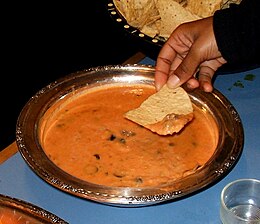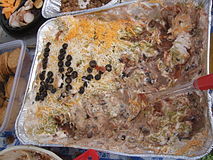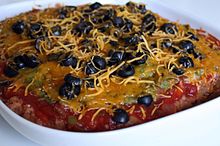Bean dip: Difference between revisions
+ |
|||
| Line 22: | Line 22: | ||
==Use in other dishes== |
==Use in other dishes== |
||
Bean dip may be prepared as or used as an ingredient in a [[seven-layer dip]],<ref name="Allen Westmoreland 2004"/> which includes the addition of ingredients such as shredded cheese, tomatoes, lettuce, salsa, sour cream, olives and chili peppers.<ref name="BettyCrocker.com"/>. Bean dip may also be used as an ingredient in other dishes and foods, such as quesadillas,<ref name="Fenster 2011"/><ref name="Madison 2014"/> burritos<ref name="Bannan 2010"> and [[nachos]], among others. |
Bean dip may be prepared as or used as an ingredient in a [[seven-layer dip]],<ref name="Allen Westmoreland 2004"/> which includes the addition of ingredients such as shredded cheese, tomatoes, lettuce, salsa, sour cream, olives and chili peppers.<ref name="BettyCrocker.com"/>. Bean dip may also be used as an ingredient in other dishes and foods, such as quesadillas,<ref name="Fenster 2011"/><ref name="Madison 2014"/> burritos<ref name="Bannan 2010"/> and [[nachos]], among others. |
||
<gallery class="center" caption="" widths="220px" heights="160px"> |
<gallery class="center" caption="" widths="220px" heights="160px"> |
||
Revision as of 08:22, 25 March 2016

Bean dip is a type of dipping sauce made from beans or refried beans. It is typically served with tortilla chips, and may also be served with crackers[1] and crudités. Various types of beans and ingredients may be used, and it may be served cold, at room temperature, or hot. It may be prepared as a vegan and gluten-free dish. Bean dip may be used as an ingredient in the preparation of other dishes such as burritos and quesadillas.
Preparation


Various types of beans can be used in bean dip's preparation, including black beans, pinto beans,[1] kidney beans, white beans, fava beans, lima beans and edamame, a preparation of immature soybeans in the pod.[2] Raw beans that are soaked and cooked may be used,[2] as can prepared canned beans and refried beans.[3][4] The use of canned beans can result in a creamier dip, because beans prepared in canneries are pressure cooked in the can,[3] creating a product with a creamier mouthfeel. Prepared canned green chili peppers may also be used.[5] Prepared dried bean flakes may also be used in the dish's preparation.[6] The bean flakes are reconstituted into a bean paste using boiling water.[6]
A myriad of additional ingredients may be used, including onion, garlic, roasted red bell pepper, red and green chili peppers, lime, lime juice, lime zest, lemon juice, vinegar, oil, lard, spices such as cumin, coriander, chili powder and cayenne, hot sauce, salt, pepper and water.[1][2][3][4][7][8]
The various ingredients may be mixed or puréed together using a food processor,[1][3] a blender, or by hand. Bean dip may be topped with shredded cheese[2] and garnished with ingredients such as chopped cilantro, chopped green onion, chopped fresh or dried parsley[1][3] and lime zest, among others.
Bean dip may be prepared as a vegan and gluten-free dish.[8]
Commercial varieties
Some companies mass-produce bean dips, such as Frito-Lay, which produces Fritos Bean Dip.[9]
Service
Bean dip may be served cold, at room temperature, or as a hot dish.[5]
Use in other dishes
Bean dip may be prepared as or used as an ingredient in a seven-layer dip,[10] which includes the addition of ingredients such as shredded cheese, tomatoes, lettuce, salsa, sour cream, olives and chili peppers.[11]. Bean dip may also be used as an ingredient in other dishes and foods, such as quesadillas,[1][12] burritos[13] and nachos, among others.
-
Close-up view of a seven-layer bean dip
Gallery
- Bean dips
-
A bean dip prepared with white beans and parmesan cheese, served with pita bread
-
Herbed white bean dip with crudités
-
Spring rolls with a black bean dipping sauce
-
Bissara is a Moroccan broad bean dip
-
A bean dip prepared with white beans and roasted red pepper, on a tortilla chip
-
Bean dip prepared with white beans
-
Black bean dip with tortilla chips
-
Close-up view of a lima bean dip
-
A bean dip served with plantain chips
See also
References
- ^ a b c d e f Fenster, C. (2011). 1,000 Gluten-Free Recipes. 1,000 Recipes. Houghton Mifflin Harcourt. p. 132. ISBN 978-0-544-18909-6.
- ^ a b c d Weimer, J.; Williams, C.; Bettencourt, B.; Williams-Sonoma (2005). Hors D'oeuvres. Williams Sonoma mastering. Free Press. pp. 56–57. ISBN 978-0-7432-6738-0.
- ^ a b c d e Flay, B.; Moskin, J.; Dolan, J.; Hyers, G. (2007). Bobby Flay's Boy Gets Grill. Scribner. pp. 34–35. ISBN 978-1-4391-0032-5.
- ^ a b Back, V.L. (2008). What's Left on the Menu. AuthorHouse. pp. 3–4. ISBN 978-1-4343-7596-4.
- ^ a b Atlas, N. (2009). The Vegetarian 5-Ingredient Gourmet. Potter/TenSpeed/Harmony. p. 235. ISBN 978-0-307-49281-4.
- ^ a b Hobbs, S.H. (2009). Living Vegetarian For Dummies. --For dummies. Wiley. p. 93. ISBN 978-0-470-61640-6.
- ^ Waskey, F.H. (2010). All-American Bean Book. Touchstone. p. 24. ISBN 978-1-4391-4522-7.
- ^ a b Hester, K.; Comet, R. (2013). The Great Vegan Bean Book. Fair Winds Press. pp. 50–52. ISBN 978-1-61058-747-1.
- ^ Janda, Greg (February 15, 2012). "Arlington Frito-Lay Plant Catches Fire". NBC 5 Dallas-Fort Worth. Retrieved March 25, 2016.
- ^ Allen, B.; Westmoreland, S. (2004). Good Housekeeping Great American Classics Cookbook. Hearst Books. p. 15. ISBN 978-1-58816-280-9.
- ^ "Seven-Layer Bean Dip". BettyCrocker.com. Retrieved March 25, 2016.
- ^ Madison, D. (2014). The New Vegetarian Cooking for Everyone. Potter/TenSpeed/Harmony. p. pt379. ISBN 978-1-60774-554-9.
- ^ Bannan, P. (2010). Eat Right When Time Is Tight: 150 Slim-Down Strategies and No-Cook Food Fixes. NorlightsPress. p. 73. ISBN 978-1-935254-29-4.











